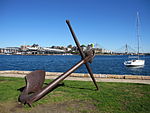Goat Island (Port Jackson)

Goat Island is a heritage-listed island located in Port Jackson, in Sydney, New South Wales, Australia. Located north-west of the Sydney central business district, Goat Island is about 300m wide in a north/south direction and 180m long in an east/west direction; and covers an area of 5.4 hectares (13 acres). Goat Island lies off the shores of the Sydney suburbs of Balmain and Millers Point, at the junction of Darling Harbour with the main channel of Sydney Harbour. The island is a former gunpowder storage, arsenal, bacteriology station, shipyard, powder magazine, maintenance facility and accommodation and now interpretation centre and education facility. Over the years Goat Island has served as a quarry, convict stockade, explosives store, police station, fire station, boatyard and film set. Today the island forms part of the Sydney Harbour National Park. The built facilities on the island were designed by Edmund Blacket and Alexander Dawson and built from 1826 to 1994. Goat Island is also known as Memel or Me-Mel, meaning the eye. The property is owned by the NSW Office of Environment and Heritage, an agency of the Government of New South Wales. It was added to the New South Wales State Heritage Register on 2 April 1999.
Excerpt from the Wikipedia article Goat Island (Port Jackson) (License: CC BY-SA 3.0, Authors, Images).Goat Island (Port Jackson)
Clifton Lane, Sydney Balmain East
Geographical coordinates (GPS) Address Nearby Places Show on map
Geographical coordinates (GPS)
| Latitude | Longitude |
|---|---|
| N -33.8521 ° | E 151.1966 ° |
Address
Clifton Lane Steps
Clifton Lane
2041 Sydney, Balmain East
New South Wales, Australia
Open on Google Maps








